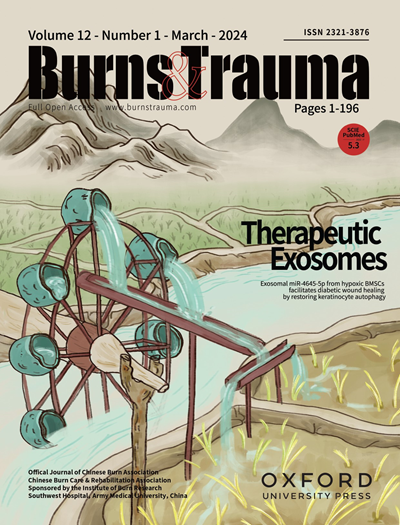Type 3 deiodinase activation mediated by the Shh/Gli1 axis promotes sepsis-induced metabolic dysregulation in skeletal muscles
IF 9.6
1区 医学
Q1 DERMATOLOGY
引用次数: 0
Abstract
Background Non-thyroidal illness syndrome is commonly observed in critically ill patients, characterized by the inactivation of systemic thyroid hormones (TH), which aggravates metabolic dysfunction. Recent evidence indicates that enhanced TH inactivation is mediated by the reactivation of type 3 deiodinase (Dio3) at the tissue level, culminating in a perturbed local metabolic equilibrium. This study assessed whether targeted inhibition of Dio3 can maintain tissue metabolic homeostasis under septic conditions and explored the mechanism behind Dio3 reactivation. Methods A retrospective clinical study was conducted to investigate the attributes of rT3. The expression of Dio3 was detected by immunoblotting, immunofluorescence, and immunohistochemical staining in tissues extracted from CLP-induced septic rats and human biopsy samples. In addition, the effect of Dio3 inhibition on skeletal muscle metabolism was observed in rats with targeted Dio3 knockdown using an adeno-associated virus. The effectiveness of Sonic hedgehog (Shh) signaling inhibition on systemic TH levels was observed in CLP-induced septic rats receiving cyclopamine. The mechanisms underlying such inhibition were explored using immunoblotting, RNA-seq, and chromatin immunoprecipitation–qPCR assays. Results The main product of Dio3, rT3, is strongly associated with organ function. Early sepsis leads to significant upregulation of Dio3 in the skeletal muscles and lung tissues of septic rats. The targeted inhibition of Dio3 in skeletal muscle restores TH responsiveness, prevents fast-to-slow fiber conversion, preserves glucose transporter type 4 functionality, and maintains metabolic balance between protein synthesis and proteolysis, which leads to preserved muscle mass. The reactivation of Dio3 is transcriptionally regulated by the Shh pathway induced by the signal transducer and activator of transcription 3. Conclusions The suppression of Dio3 restores tissue TH actions, attenuates proteolysis, and ameliorates anabolic resistance in the skeletal muscles of septic rats, thereby improving local metabolic homeostasis. Our results provide insights into the mechanisms of Dio3 reactivation and its critical role in local metabolic alterations induced by sepsis, while also suggesting novel targets aimed at ameliorating tissue-specific metabolic disorders.Shh/Gli1轴介导的3型脱碘酶激活促进败血症诱导的骨骼肌代谢失调
背景非甲状腺疾病综合征常见于危重患者,其特征是全身甲状腺激素(TH)失活,从而加重代谢功能障碍。最近的证据表明,增强TH失活是由3型脱碘酶(Dio3)在组织水平上的再激活介导的,最终导致局部代谢平衡被扰乱。本研究评估了在脓毒症条件下靶向抑制Dio3是否能维持组织代谢稳态,并探讨了Dio3再激活的机制。方法回顾性分析rT3的临床特点。通过免疫印迹、免疫荧光和免疫组化染色检测clp诱导的脓毒症大鼠组织和人体活检样本中Dio3的表达。此外,利用腺相关病毒靶向敲除Dio3对大鼠骨骼肌代谢的影响进行了观察。在接受环巴胺的clp诱导的脓毒症大鼠中,观察了Sonic hedgehog (Shh)信号抑制对全身TH水平的影响。使用免疫印迹、RNA-seq和染色质免疫沉淀- qpcr分析来探索这种抑制的机制。结果Dio3的主要产物rT3与器官功能密切相关。早期脓毒症导致脓毒症大鼠骨骼肌和肺组织中Dio3的显著上调。骨骼肌中Dio3的靶向抑制恢复TH反应性,阻止快到慢纤维转化,保持葡萄糖转运蛋白4型功能,维持蛋白质合成和蛋白质水解之间的代谢平衡,从而保持肌肉质量。Dio3的再激活是由转录3的信号转导和激活因子诱导的Shh通路调控的。结论抑制Dio3可恢复败血症大鼠组织TH活性,减弱蛋白水解,改善骨骼肌合成代谢抵抗,从而改善局部代谢稳态。我们的研究结果揭示了Dio3再激活的机制及其在败血症引起的局部代谢改变中的关键作用,同时也提出了旨在改善组织特异性代谢紊乱的新靶点。
本文章由计算机程序翻译,如有差异,请以英文原文为准。
求助全文
约1分钟内获得全文
求助全文
来源期刊

Burns & Trauma
医学-皮肤病学
CiteScore
8.40
自引率
9.40%
发文量
186
审稿时长
6 weeks
期刊介绍:
The first open access journal in the field of burns and trauma injury in the Asia-Pacific region, Burns & Trauma publishes the latest developments in basic, clinical and translational research in the field. With a special focus on prevention, clinical treatment and basic research, the journal welcomes submissions in various aspects of biomaterials, tissue engineering, stem cells, critical care, immunobiology, skin transplantation, and the prevention and regeneration of burns and trauma injuries. With an expert Editorial Board and a team of dedicated scientific editors, the journal enjoys a large readership and is supported by Southwest Hospital, which covers authors'' article processing charges.
 求助内容:
求助内容: 应助结果提醒方式:
应助结果提醒方式:


